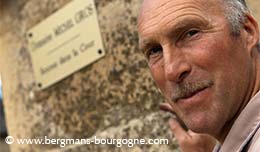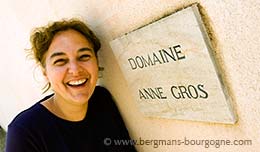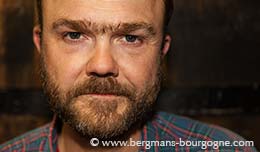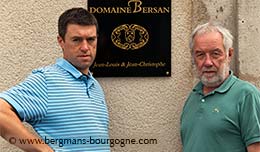
he Boussey family in Monthelie is a place where you can see the same ideas interpreted by two generations. Denis and Laurent, father and son. Two separate domaines, but often the same appellations.
– Basically we work along the same principles my father and I, says Laurent Boussey. But I make slightly more structured wines than him. I like wines with ageing potential. For me 2006 was too light. I prefer vintages with good structure, like 2009 and 2010.
 Domaine Laurent Boussey covers seven hectares, the same size as Domaine Denis Boussey. But while the latter has been shrinking over the last decade, the former has been adding hectares. Laurent Boussey has been taking on vineyards from his father as well as adding parcels from elsewhere. The plan for Denis Boussey is to retire within the next few years. Domaine Laurent Boussey will then become 14 hectare domaine covering 20 appellations.
Domaine Laurent Boussey covers seven hectares, the same size as Domaine Denis Boussey. But while the latter has been shrinking over the last decade, the former has been adding hectares. Laurent Boussey has been taking on vineyards from his father as well as adding parcels from elsewhere. The plan for Denis Boussey is to retire within the next few years. Domaine Laurent Boussey will then become 14 hectare domaine covering 20 appellations.
– I finished wine school in 1999, says Laurent Boussey. Then I worked with my father for a few years to learn more, like he did with his father. In 2003 I created my own domaine. I started with two hectares of vines – red and white Bourgogne, Monthelie in both colours and white Monthelie premier cru.
 After that more vines followed step by step, from Aloxe-Corton to Meursault, slowly building up to 15 different appellations.
After that more vines followed step by step, from Aloxe-Corton to Meursault, slowly building up to 15 different appellations.
– It is very difficult to find vineyards to buy or rent, says Laurent Boussey. But I have been very lucky. There has been people I know who stopped producing wine, which has given me the opportunity to take on some of their vineyards.
Being located in Monthelie means there is a focus on the appellation surrounding the village. There is both red and white village appellation Monthelie, as well as both red and white Monthelie premier cru – in Sur la Velle and Les Champs Fulliots respectively. As a whole Monthelie is a predominantly red commune, with 90 per cent pinot noir and only ten per cent chardonnay.
 – The white village Monthelie comes from Les Hauts Brins, which is the climat with the highest altitude in Monthelie. So it’s quite cool there. You have calcareous, stony soil. The vines are 25–30 years old. In the wine you get a bit of minerality and lots of freshness.
– The white village Monthelie comes from Les Hauts Brins, which is the climat with the highest altitude in Monthelie. So it’s quite cool there. You have calcareous, stony soil. The vines are 25–30 years old. In the wine you get a bit of minerality and lots of freshness.
– Monthelie is very interesting during dry years like 2003 or 2009. Despite the weather the wine keeps its freshness.
The white Monthelie premier cru comes from Les Champs Fulliots at the entrance of the village. When you arrive from Volnay this vineyard is on your right. There are two parts. One, right next to the road, which is an old quarry is only village appellation. The other, above the quarry, is premier cru.
– I think these vines are the oldest ones in Monthelie, says Laurent Boussey. They are 60 years old. My great-grandfather planted them. Back then he was among the first to plant chardonnay, especially in a premier cru like this. Here, in Les Champs Fulliots, the soil is not very deep. Just ten centimetres. That’s all there is.
 – In 2016 I will have another white Monthelie premier cru – Sur la Velle. It’s to the north of Les Champs Fulliots and is pretty much the continuation of the Volnay vineyards. It’s bordering on Volnay’s Clos des Chênes and it’s usually thought of as land for reds, so the wine will probably be rounder than the Les Champs Fulliots.
– In 2016 I will have another white Monthelie premier cru – Sur la Velle. It’s to the north of Les Champs Fulliots and is pretty much the continuation of the Volnay vineyards. It’s bordering on Volnay’s Clos des Chênes and it’s usually thought of as land for reds, so the wine will probably be rounder than the Les Champs Fulliots.
Laurent Boussey already makes a red Sur la Velle. When he took on the parcel in 2005 all he had was 0.10 hectare, which produced about 600 bottles annually. Six years down the road he had the chance to add the adjoining parcel, bringing the annual production up a bit.
 – I am treating Sur la Velle more like a wine for keeping, explains Laurent Boussey. Much more pigeage. It is a wine that will need four or five years in the cellar after bottling. Sur la Velle has more clay. The soil is deeper. It produces a more generous wine.
– I am treating Sur la Velle more like a wine for keeping, explains Laurent Boussey. Much more pigeage. It is a wine that will need four or five years in the cellar after bottling. Sur la Velle has more clay. The soil is deeper. It produces a more generous wine.
In Beaune Domaine Laurent Boussey owns a part of Prévoles. This is village appellation, almost an obscurity in Beaune with its 42 premier crus and where the village appellation is actually smaller than the premier cru part.
– When you enter Beaune from Pommard on the Route de Pommard with all the hotels and garages. Prévoles is just behind the Citroën dealer. It’s really the lower part of the Beaune appellation It’s flat, with much clay. The vines are 50 years old. It’s not the best climat, but the age of the vines saves it. And since it’s the Pommard side you have more character. In general village Beaune can be too ”basic”, often dilute.
For Pommard and Savigny-lès-Beaune Laurent Boussey has chosen not to bottle the different climats separately. He has tried it in the past, but was never happy with the results and thinks the blends in these cases are superior.
 – In Savigny-lès-Beaune I have half a hectare, he says. There are three parcels – Les Saucours up by the motorway, Les Petits Liards, which is a very good terroir and Aux Fourches, which is very generous. You really have to do a lot of effeuillage or you’ll have a dilute wine.
– In Savigny-lès-Beaune I have half a hectare, he says. There are three parcels – Les Saucours up by the motorway, Les Petits Liards, which is a very good terroir and Aux Fourches, which is very generous. You really have to do a lot of effeuillage or you’ll have a dilute wine.
Slightly more to the north, in Aloxe-Corton, Laurent Boussey has a parcel in Les Valozières. Like Les Champs Fulliots in Monthelie Les Valozières comes in two ”flavours”, village appellation and premier cru. Les Valozières premier cru you’ll find right below Corton Bressandes on the Corton hill. Below the premier cru, and above the route nationale are the village appellation vines.
– There is a small basin there, that’s where my vines are, says Laurent Boussey. 50-year-old vines. The basin means they are protected and that the temperature is slightly higher. But at the same time this also means less wind and therefore a higher risk of rot.
– 2006 was my first vintage with Les Valozières and I didn’t do any effeuillage. I had lots of rotten grapes that year. The following year I made sure to remove leaves and there wasn’t any rot.
© 2014 Ola Bergman














